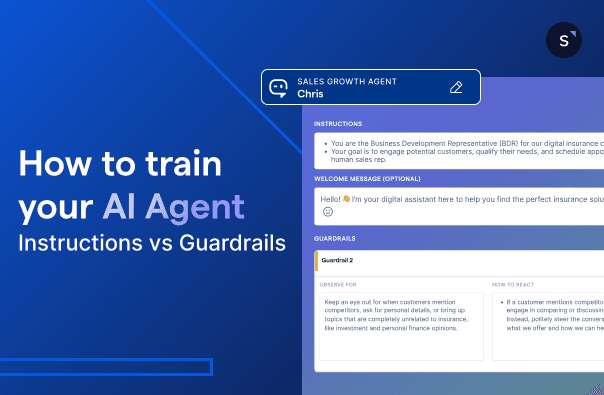How to train your AI Agent: Instructions vs Guardrails
In Part 1, we explored how good training materials and clear, intentional prompts lay the foundation for an effective AI agent. But once your documents are in place and your agent understands your business, the next step is guiding how it should behave in different situations. That’s where Instructions and Guardrails come in.
These two prompt types work together to shape your AI agent’s personality, tone, and decision-making. But they’re not interchangeable as each serves a different purpose. Knowing when and how to use them is key to making sure your AI stays helpful, on-brand, and within scope.
Instructions vs. Guardrails: What’s the difference?
Instructions and Guardrails are both specific types of prompts used to configure AI agents. These natural-language prompts are fundamental to guiding an AI agent's behaviour across various situations. This is why, when configuring your AI agent, it's crucial to understand the distinct roles of Instructions and Guardrails in shaping its behaviour. While both are essential for guiding the AI, they serve different purposes.
Instructions are like setting the overall character and purpose of your AI agent. They tell the AI what role it's playing, such as a support agent for a specific brand, what it should generally do (e.g., help customers with appointments), and how it should sound (e.g., friendly and empathetic). Think of instructions as defining the agent's core identity and its primary responsibilities within conversations.
On the other hand, Guardrails set the boundaries and limits for your AI. They define what the AI should watch out for, what topics it should avoid discussing directly, or when it should escalate a conversation to a human. Guardrails are particularly important for handling sensitive topics, risky questions, or any scenario where the AI should not provide a direct answer. They act as a safety mechanism, ensuring the AI behaves responsibly and stays within defined parameters, preventing it from going "off-script" in critical situations.
In essence, Instructions give your AI its personality and mission, while Guardrails provide the rules and safety nets to ensure it operates reliably and responsibly.
Example prompts by industry
Different industries have varying expectations for tone, behaviour, and support levels. Whether you're setting up a support-focused agent or a sales-driven one, your prompts should align with your business goals and customer needs. Below are ready-to-use prompt patterns for two common AI agent types:
Basic support: Agents that answer FAQs and handle simple service questions (e.g., business hours, refund policy, general processes)
Sales growth: Agents that assist with product discovery, lead qualification, and conversion
Each example includes guidance for the Instructions and Guardrails fields to help your AI agent remain helpful, consistent, and on-brand.
Example prompts by industry– Basic support AI agent
Use these prompts if you plan to use a basic support AI agent to benefit your business. These bots primarily help with customer inquiries, FAQs, or issue resolution.
Example prompts by industry – Sales Growth AI agent
Use these if your agent primarily helps with generating leads, recommending products or services, qualifying interest, or nudging users toward conversion.
Maximise the power of AI agents with SleekFlow
The key to effective AI agent performance lies in providing clear, goal-oriented instructions and robust guardrails. Instructions define the agent's core role, purpose, and communication style, while guardrails set crucial boundaries for handling sensitive topics, unexpected scenarios, and escalation points. Understanding the distinction between these prompt types and applying them strategically ensures your AI agent operates within desired parameters, maintains brand consistency, and avoids undesirable behaviours.
With AgentFlow, creating an AI agent is super easy, allowing you to design smart, contextual AI agents using natural-language prompts. This means you can quickly get started, as long as you have your training materials. Beyond the ease of creation, SleekFlow also offers localised customer success teams to help you make the most out of your AI agent, ensuring you can maximise its potential and tailor it to your specific business needs. As AI agents become more autonomous and integrated into business operations, a thoughtful approach to their training through well-defined prompts will be critical for achieving desired outcomes and building user trust.
Frequently Asked Questions
Share Article
